Before landing a starry night sky is below us. This is Delhi by night.
We beat back taxi drivers’ attack, check that people are still sleeping in the hotel and bargain a better price for cab ride than the one offered by the hotel. Already everything is hot, sticky and in pinkish light.
In the hotel they want 500 rupees extra for getting the room immediately. It’s seven o’clock, the check-in time is noon. We take one room right away. Enough space for three people to sleep in a row. Maybe we don’t need the other room at all? Just few days ago we turned back the offer for all of us to share a bed from Sudhir after it turned out that his son has postponed his departure to the US because their dog is very ill.
We slowly wake up, pour cold water over us and go looking for food and currency exchange. Banks are a little bit closed and the rate is a little bit better than at the airport.
For 3 o’clock we drive to Red Fort parking place to meet Nabarun. Nabarun gives us a quick overview of Delhi’s history and takes us to see vanishing havelis or old mansions. They are disappearing because a lot of them were burned and bombed during or after the Great Mutiny in 1857, the owners of the surviving ones escaped or were killed. A lot were demolished by the British in order to build Lutyens' Delhi. Squatters haven’t been the best preservers of property.
On ground floor of most delapidated havelis are shops, upper floors hold living quarters. Renovating such a house is expensive and brings with it the hassle and paperwork of inheritage protection.
Havelis are in different stage of being turned into ruins. From some only the gate to inner courtyard is preserved, some have entire inner facade left, paint crumbling, washing and air conditioners hanging on the walls. From one courtyard the fountain has been removed just two weeks ago. In India a thing is not valued just because it is old. The only restored haveli is the one where Ghalib, the most famous poet of Mughal dawn, used to live.
Between taking in architecture we taste street food and experience the market. The market is a well organised chaos. Vendors are gathered together by the type of items, there are separate streets for wedding necessities, jewellery, glasses, car parts, spices. Heavy baskets are carried along narrow streets, in shops people relax on carpets and the economy grows. The workers are mainly from rural areas.
Finally Nabarun puts us back where he took us. Traffic jams have arrived so we’re late for dinner with Sudhir. Sudhir lives in a house where armed guards control the entrance and visitors have to write their names down in a big journal. For start there are snacks and whiskey. When we are just about full the real dinner starts. We talk mostly about traveling and meet Sudhir’s daughter and son. His daughter is going to study anthropology in Oxford and his son is already studying at MIT. After midnight mango we let a taxi take us back to our hotel. The night will probably be spent with digestion.
In the hotel they want 500 rupees extra for getting the room immediately. It’s seven o’clock, the check-in time is noon. We take one room right away. Enough space for three people to sleep in a row. Maybe we don’t need the other room at all? Just few days ago we turned back the offer for all of us to share a bed from Sudhir after it turned out that his son has postponed his departure to the US because their dog is very ill.
We slowly wake up, pour cold water over us and go looking for food and currency exchange. Banks are a little bit closed and the rate is a little bit better than at the airport.
For 3 o’clock we drive to Red Fort parking place to meet Nabarun. Nabarun gives us a quick overview of Delhi’s history and takes us to see vanishing havelis or old mansions. They are disappearing because a lot of them were burned and bombed during or after the Great Mutiny in 1857, the owners of the surviving ones escaped or were killed. A lot were demolished by the British in order to build Lutyens' Delhi. Squatters haven’t been the best preservers of property.
On ground floor of most delapidated havelis are shops, upper floors hold living quarters. Renovating such a house is expensive and brings with it the hassle and paperwork of inheritage protection.
Havelis are in different stage of being turned into ruins. From some only the gate to inner courtyard is preserved, some have entire inner facade left, paint crumbling, washing and air conditioners hanging on the walls. From one courtyard the fountain has been removed just two weeks ago. In India a thing is not valued just because it is old. The only restored haveli is the one where Ghalib, the most famous poet of Mughal dawn, used to live.
Between taking in architecture we taste street food and experience the market. The market is a well organised chaos. Vendors are gathered together by the type of items, there are separate streets for wedding necessities, jewellery, glasses, car parts, spices. Heavy baskets are carried along narrow streets, in shops people relax on carpets and the economy grows. The workers are mainly from rural areas.
Finally Nabarun puts us back where he took us. Traffic jams have arrived so we’re late for dinner with Sudhir. Sudhir lives in a house where armed guards control the entrance and visitors have to write their names down in a big journal. For start there are snacks and whiskey. When we are just about full the real dinner starts. We talk mostly about traveling and meet Sudhir’s daughter and son. His daughter is going to study anthropology in Oxford and his son is already studying at MIT. After midnight mango we let a taxi take us back to our hotel. The night will probably be spent with digestion.
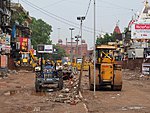
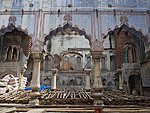
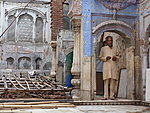
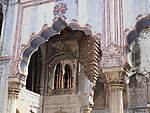
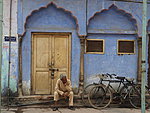
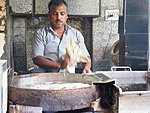
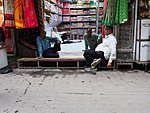
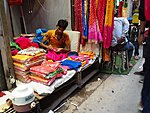
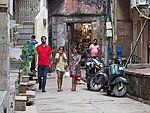
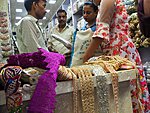
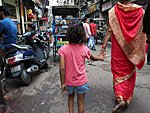
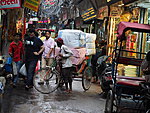
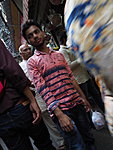
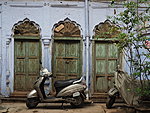
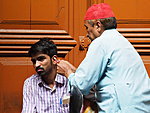
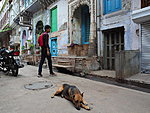
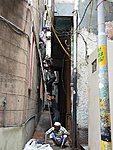
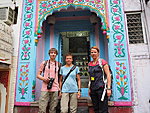
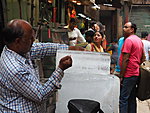
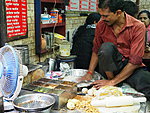
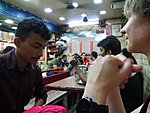
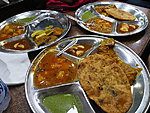
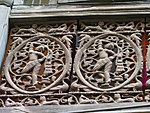

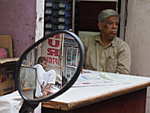

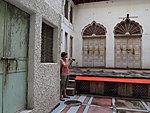

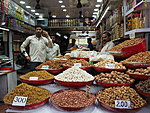
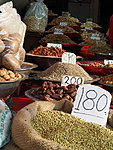
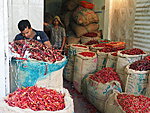

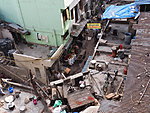
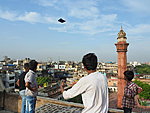
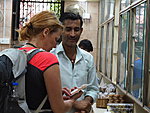
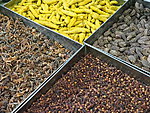
Add a comment